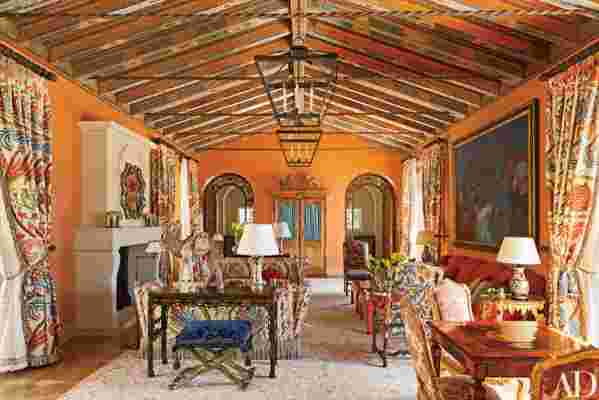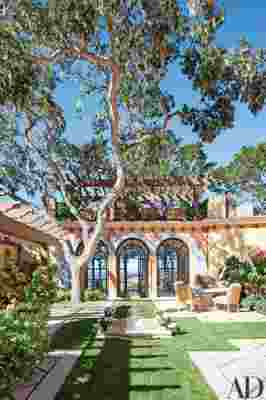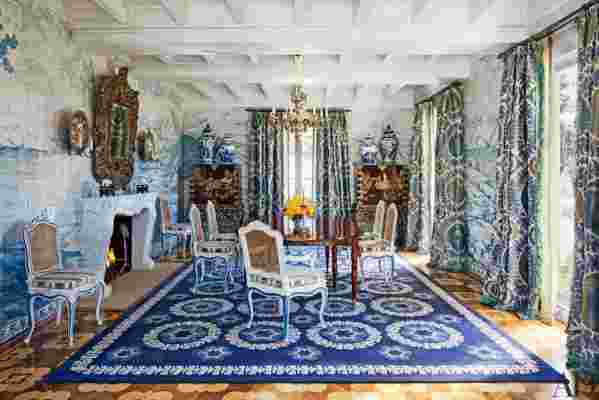April 04,2022
Juan Pablo Molyneux Crafts a Splendid Villa in Pebble Beach
by David Stewart
This article originally appeared in the August 2014 issue of Architectural Digest.
Several years ago Juan Pablo Molyneux was asked to vet four properties in Pebble Beach, California, for a longtime client. The coastal enclave is the site of a storied annual vintage-automobile competition, the Concours d’Elegance, and the client, an old friend, owned an important collection of classic racing cars. He and the Chilean-born designer shared a courtly Latin demeanor, a decisive temperament, and a love of speed, though Molyneux himself prefers two wheels to four—he drives a Harley. And he’s just as fearless when it comes to opulence.
The vetting process took just a day. "I called my client from the Monterey airport," the Paris- and New York–based decorator recalls. "The choice was obvious, and when I missed my flight, I used the delay to sketch the plans for a rather ambitious renovation. ‘We’ll add a wing,’ I told him. ‘We’ll build a loggia to enclose the courtyard. You ought to have a library off the master suite. The architecture is distinguished, though it’s underdressed. But this is the house you have to buy—it has so much potential.’" As Molyneux tells it, there was a cheerfully fatalistic sigh at the other end of the line, and the client, well-versed in the designer’s ways, said, "Here we go again. I know what ‘potential’ means."
The residence, a Spanish Colonial–style villa from the 1920s, sits on a bluff overlooking the Pacific. The views and setting were exceptional, and the public rooms were graciously proportioned, though in Molyneux’s opinion, "they lacked personality." In the living room, he expanded the windows and gave depth to the walls with Venetian plaster. A decorative painter antiqued the beams of the cathedral ceiling, which looks as if it were imported from Mexico. The room’s palette now evokes a basket of figs, melons, and apricots ripened by the sun. Elsewhere in the house, intensely textured spaces, among them a vaulted anteroom covered in embossed leather, alternate with serenely spare ones, such as a columned gallery where feathery palm fronds climb pale Nile-green walls.
Every Molyneux interior has its grand gesture, and in the Pebble Beach house it’s the dining room. The designer sheathed the walls in blue-and-white tile using a technique he perfected in his own Paris home. Except here he wanted to create a scenic mural. "First we needed a subject," he says. "I found a beautiful engraving of San Francisco Bay, a view of the harbor, the hills, and the Spanish mission." The image was scanned and enlarged digitally, then transferred to the unfired clay tiles.
Glossy white ceramic is also employed to brilliant effect in the room, both on the columns that frame the entrance—their trompe l’oeil shadows are rendered in blue on the adjoining jambs—and on the mantel, whose voluptuous contours suggest the kinship between rococo and Art Nouveau embellishment. An antique French silver-gilt mirror above the fireplace converses with a silver-and-bronze Régence chandelier. "With so many reflective surfaces," Molyneux notes, "the room shimmers like the sea on a foggy morning and sparkles by candlelight. It’s magical."



While the tiles were being fabricated in France (they would arrive with the French team that installed them), Molyneux focused on the dining room furnishings. "I wanted patterns that were huge in scale," he said, "partly to make the space forget it was once a dull beige, and partly to assert its Spanish character. Chintz, for example, would have been too Anglo-Saxon." A daintier floor might have spoiled the effect, but the bold parquet, with its barbed quatrefoil inlay, refuses to behave like a doormat. The exuberant motifs and delftware-inspired palette of the rug are echoed in the drapery fabric, the painted chairs, and the porcelain jars displayed atop a pair of rare 18th-century Chinese cabinets. One might have expected a monastery dining table, something from a set for Don Carlo, but the designer instead chose a provincial French antique. "Colonial craftsmen would also have copied European heirlooms," he observes, "so the table’s rustic charm—its aspiration to refinement—felt right for the house."
California has assimilated waves of conquest and migration, and the villa’s interiors mirror the state’s cultural diversity. "Nothing in the decor matches," Molyneux says, "yet everything vibrates in harmony." Carpets are Chinese and Caucasian. Wallpapers were handmade in Istanbul. Contemporary paintings mingle with pre-Columbian statuary. And outside the dining room, a tiled wall depicts a noble sentinel: the figure of a warrior from a West Coast tribe, among the first Americans the Spanish encountered.
It takes supreme confidence to layer styles, periods, and patterns with such abandon, and supreme discipline to control the mix. And here, perhaps, it is worth noting that a perfectionist, in Spanish, is a detallista: a master of detail.






